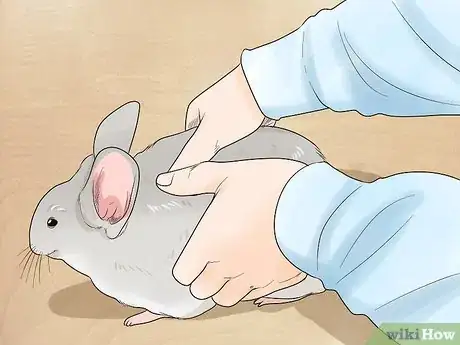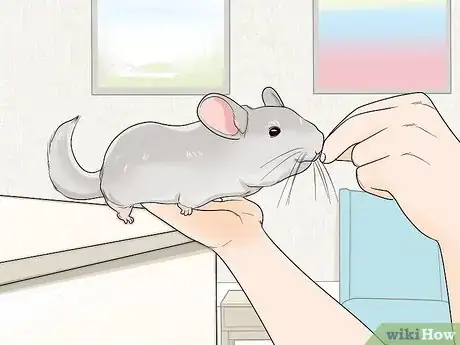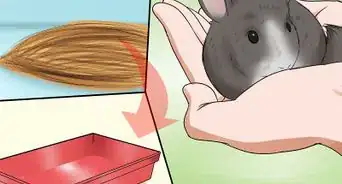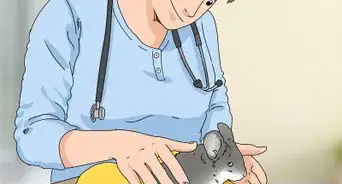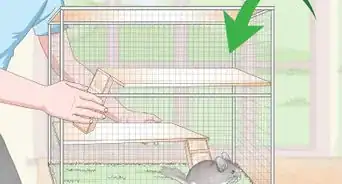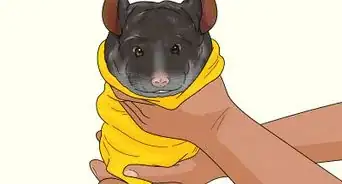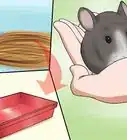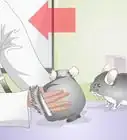This article was co-authored by wikiHow Staff. Our trained team of editors and researchers validate articles for accuracy and comprehensiveness. wikiHow's Content Management Team carefully monitors the work from our editorial staff to ensure that each article is backed by trusted research and meets our high quality standards.
There are 7 references cited in this article, which can be found at the bottom of the page.
This article has been viewed 12,267 times.
Learn more...
Chinchillas are sensitive, active, and intelligent creatures. Providing a chinchilla with a healthy and active lifestyle requires a lot of dedication, as they need at least an hour of exercise every evening. With some thorough preparation, patience, and supervision, you can let a chinchilla out of its cage and begin to form a bond with it that will last for years to come.
Steps
Chinchilla-Proofing the Room
-
1Choose a playroom for your chinchilla. Chinchillas are active creatures that run, jump, and climb, so you’ll want to avoid choosing a playroom that has slick flooring like linoleum or tile. A large, carpeted, cool, temperature-controlled room is best.[1]
- Bathrooms are not a good choice because of their tile/linoleum flooring, and the shower’s humidity can cause mold and mildew, which your curious chinchilla will likely find in small crevices.
- If you aren’t able to chinchilla-proof an entire room, consider a large playpen for their activities.[2]
-
2Shut all doors and windows. Seal those exits! You may also consider getting a hanger for the doorknob of the room to alert others when your chinchilla is out playing. Even under constant supervision, it only takes a moment for your chinchilla to scurry out the playroom.[3]Advertisement
-
3Remove cords from electronics. If you can’t remove them all together, wrap exposed electronic cables and wire in a towel/cloth or hard casing. Take the same precaution with furniture and wrap towels or sheets around the legs. Chinchillas chew and gnaw on just about anything. When in doubt, take it out![4]
- Be careful to not use towels or sheets with frayed edges, as your chinchilla is just as likely to chew on those as well.[5]
-
4See things from the chinchilla’s point of view. Get on the floor and crawl around, checking for anything harmful your chinchilla might chew on. Also look for any small, potentially dangerous spaces your chinchilla could hide.
-
5Prep the room for activities. Chinchillas need places to climb, hide, and explore, or they will become bored and start to cause mischief. Fill the room with toys they can chew on and places to play and hide.
Taking Your Chinchilla out of Its Cage
-
1Get your chinchilla used to your smell and voice. Talk to your chinchilla and start by sticking your hand in its cage, with your palm up. Your chinchilla should eventually come to your hand to smell you, and may even hop into your hand.
- Because chinchillas are typically anxious and easily startled, especially when you first bring them home, it may take a while before you can get it out of its cage. Try not to get discouraged.
-
2Interact with your chinchilla daily. The more frequently you interact with your chinchilla, the quicker it will become used to you. Over time, you should be able to get your chinchilla out of its cage without chasing it.
- You can also use a reward system for your chinchilla. If it allows you to pet it for a bit, give it a treat. They are smart creatures and will quickly learn that you are their friend this way.
-
3Pick up your chinchilla with both hands. It is important to support your chinchilla’s full body weight and hold it close to you. Use one hand to support its front legs and the other to support its back legs and hindquarters. [9]
- Be careful to not squeeze your chinchilla. Its bones are fragile and can easily be broken.
- Be careful with a chinchilla’s tail when holding it. You can grasp the base of its tail, but grabbing any other part of it may result in the tail breaking off or serious damage to the nerves.
- Hold the chinchilla close to your chest, but don’t pressure it to cuddle with you for too long. Keep an eye on its body language. If it's squirming, let it down.[10]
Supervising Your Chinchilla
-
1Keep a constant eye on your chinchilla. Your chinchilla absolutely requires supervision when it's out of its cage. Remember that chinchillas are sensitive and curious creatures, and leaving them alone, even in a chinchilla-proof area, can be potentially harmful.
-
2Provide snacks for your chinchilla in case its blood sugar drops. Along with toys and fun, hay, treats, and water are good to have on hand in the playroom so your chinchilla can recover from exercise.
- Due to the amount of exercise they get during playtime, chinchillas can experience blood sugar crashes. If they seem to have trouble standing up or start to sway, give them a snack.[11]
- Be careful to not overfeed them sugary treats, like raisins. Overfeeding them treats while they’re exercising can cause seizures.[12]
- Chinchillas typically drink out of bottles, but you can provide a water dish for them to drink out of during play time. They will adapt.[13]
-
3Bond with your chinchilla through touch and treats. Once your chinchilla gets used to you, it may start to climb on you and want attention.[14]
- Chinchillas typically don't enjoy cuddling, but each chinchilla is different. If it doesn't try to get away, keep holding it! Like most pets, it is a good sign that they're bonding well.
- Reward them for good behavior with a treat. Remember, they're quite smart, and will keep that good behavior up if rewarded.[15]
References
- ↑ http://www.chincare.com/HealthLifestyle/Exercise.htm
- ↑ pets.amerikanki.com/tips-for-caring-for-chinchillas/2/
- ↑ http://www.chincare.com/HealthLifestyle/Exercise.htm
- ↑ http://www.chincare.com/HealthLifestyle/Exercise.htm
- ↑ http://www.chincare.com/HealthLifestyle/Exercise.htm
- ↑ http://www.chincare.com/HealthLifestyle/Exercise.htm
- ↑ https://www.thesprucepets.com/toys-for-chinchillas-1236765
- ↑ https://www.thesprucepets.com/toys-for-chinchillas-1236765
- ↑ http://www.cheekychinchillas.com/faq.html
- ↑ https://www.dogbreedinfo.com/pets/chinchilla.htm
- ↑ https://www.foreverfeistychinchilla.org/health-issues-i-z.html
- ↑ http://www.chincare.com/HealthLifestyle/Exercise.htm
- ↑ http://www.chincare.com/HealthLifestyle/Exercise.htm
- ↑ https://www.dogbreedinfo.com/pets/chinchilla.htm
- ↑ https://www.dogbreedinfo.com/pets/chinchilla.htm
- ↑ https://infolific.com/pets/chinchillas/training-chinchillas/







